Spatiotemporal Variation of Correlated Color Temperature in the Tunnel Access Zone
Abstract
:1. Introduction
1.1. Tunnel-Luminous Environment
1.2. Traffic Color Environment
1.3. Tunnel Access Zone CCT
1.4. Proposal of This Study
2. Materials and Methods
2.1. Measurement
- Select a typical tunnel (Beijing Luhua Road Tunnel is taken as an example in Figure 2), determine the stopping sight distance of the tunnel by consulting the charts;
- Position the Spectral Flickering Irradiance Meter on a tripod with a stopping sight distance (SSD) along the tunnel axis 1.5 m above the road surface, hold it perpendicular to the road, and orient the receiving end towards the tunnel portal. Place the Irradiance Meter on a horizontal surface and ensure that the device is not obscured;
- Record the CCT, the vertical illuminance, and the horizontal solar irradiance outside the tunnel; take a photograph facing the tunnel portal;
- Move the Spectral Flickering Irradiance Meter forward 10 m;
- Repeat steps 2 to 4 until the test position is at the tunnel portal;
- Repeat steps 2 to 5 in sequence every half hour until all tests for the day are completed. Determine the area share of each scene within the driver’s 20° view angle at different positions from the photographs taken in step 3.
2.2. Error Calculation and Modeling Methods
2.3. Extension and Application of the CCT Calculation Model
2.4. Technical Route
3. Results
3.1. Temporal and Spatial Variation Rules
3.1.1. CCT in the Tunnel Access Zone
3.1.2. Vertical Illuminance at the Driver’s Position and Solar Irradiance
3.2. CCT Calculation Model
3.2.1. Correlation Analysis and Input Parameter Identification
3.2.2. Correlation Analysis and Input Parameter Identification
3.3. Validation of Research Methods
3.4. Suitable CCTin for Irradiance
3.4.1. Relationship between CCT and Solar Irradiance
3.4.2. The Optimal Range of CCTin Values
4. Discussion
4.1. Recommendations for Tunnel Lighting Based on CCT Variation
4.2. Application Scenarios and Potential of the Proposed Model
5. Conclusions
- The CCT calculation model of the tunnel access zone has been established based on field test data, the modeling method has been validated, and the mean absolute percentage error can be controlled within 5% with verification, which can accurately calculate the CCT of the tunnel access zone.
- For an urban tunnel that includes the sky in the driver’s 20° field of view at the stopping sight distance, the CCT received by the driver’s eye varies in the range of 4500~7300 K. Within 20 m from the tunnel portal, CCT is mainly influenced by lighting sources inside the tunnel; in the section space between 20 and 50 m from the tunnel portal, CCT is influenced by a combination of solar radiation and lighting sources inside the tunnel portal; beyond 50 m from the tunnel portal, CCT is mainly influenced by solar radiation.
- As a result of Spearman correlation analysis, the CCT received by the driver’s eyes during the approach to the tunnel is related to the solar irradiance, the distance from the tunnel portal, and the CCT of the tunnel interior lighting.
Author Contributions
Funding
Institutional Review Board Statement
Informed Consent Statement
Data Availability Statement
Conflicts of Interest
References
- Ministry of Transport of China. Statistical Communiqúe on the Development of the Transportation Industry in 2021; Ministry of Transport of China: Beijing, China, 2022.
- Ministry of Transport of China. Statistical Communiqúe on the Development of the Transportation Industry in 2020; Ministry of Transport of China: Beijing, China, 2021.
- Ministry of Transport of China. Statistical Communiqúe on the Development of the Transportation Industry in 2019; Ministry of Transport of China: Beijing, China, 2020.
- Bassan, S. Overview of traffic safety aspects and design in road tunnels. IATSS Res. 2016, 40, 35–46. [Google Scholar] [CrossRef]
- Salata, F.; Golasi, I.; Poliziani, A.; Futia, A.; de Lieto Vollaro, E.; Coppi, M.; de Lieto Vollaro, A. Management optimization of the luminous flux regulation of a lighting system in road tunnels. A first approach to the exertion of predictive control systems. Sustainability 2016, 8, 1092. [Google Scholar] [CrossRef]
- Pannu, A. Artificial intelligence and its application in different areas. Artif. Intell. 2015, 4, 79–84. [Google Scholar]
- Lai, J.; Zhang, P.; Zhou, H.; Cheng, F.; Qin, H. Study of Rules of Traffic Accidents in Expressway Tunnels. Tunn. Constr. 2017, 37, 37–42. [Google Scholar]
- Moretti, L.; Cantisani, G.; Carrarini, L.; Bezzi, F.; Cherubini, V.; Nicotra, S. Italian road tunnels: Economic and environmental effects of an on-going project to reduce lighting consumption. Sustainability 2019, 11, 4631. [Google Scholar] [CrossRef]
- Moretti, L.; Cantisani, G.; Di Mascio, P.; Caro, S. Technical and economic evaluation of lighting and pavement in Italian road tunnels. Tunn. Undergr. Space Technol. 2017, 65, 42–52. [Google Scholar] [CrossRef]
- Qin, L.; Dong, L.; Xu, W.; Zhang, L.; Yan, Q.; Chen, X. A “vehicle in, light brightens; vehicle out, light darkens” energy-saving control system of highway tunnel lighting. Tunn. Undergr. Space Technol. 2017, 66, 147–156. [Google Scholar] [CrossRef]
- CIE. Fundamentals of the Visual Task of Night Driving; CIE Technical Report 100-1992; CIE: Taiwan, China, 1992. [Google Scholar]
- O’Donell, B.; Colombo, E.; Boyce, P. Colour information improves relative visual performance. Light. Res. Technol. 2011, 43, 423–438. [Google Scholar] [CrossRef]
- Boyce, P.; Akashi, Y.; Hunter, C.; Bullough, J. The impact of spectral power distribution on the performance of an achromatic visual task. Light. Res. Technol. 2003, 35, 141–156. [Google Scholar] [CrossRef]
- McKeefry, D.J.; Parry, N.R.; Murray, I.J. Simple reaction times in color space: The influence of chromaticity, contrast, and cone opponency. Investig. Ophthalmol. Vis. Sci. 2003, 44, 2267–2276. [Google Scholar] [CrossRef]
- O’Donell, B.M.; Barraza, J.F.; Colombo, E.M. The effect of chromatic and luminance information on reaction times. Vis. Neurosci. 2010, 27, 119–129. [Google Scholar] [CrossRef]
- Rea, M.S.; Ouellette, M.; Tiller, D.K. The effects of luminous surroundings on visual performance, pupil size, and human preference. J. Illum. Eng. Soc. 1990, 19, 45–58. [Google Scholar] [CrossRef]
- Zube; Taylor, J.G. Landscape Assessment and Perception Research Methods in Environmental and Behavioral Research; Van Nostrand Reinhold Company: New York, NY, USA, 1987; pp. 361–393. [Google Scholar]
- Chapanis, A. Hazards associated with three signal words and four colours on warning signs. Ergonomics 1994, 37, 265–275. [Google Scholar] [CrossRef]
- McGwin, G., Jr.; Brown, D.B. Characteristics of traffic crashes among young, middle-aged, and older drivers. Accid. Anal. Prev. 1999, 31, 181–198. [Google Scholar] [CrossRef]
- Dong, L.; Qin, L.; Xu, W.; Zhang, L. The impact of LED correlated color temperature on visual performance under mesopic conditions. IEEE Photonics J. 2017, 9, 8201616. [Google Scholar] [CrossRef]
- Jin, H.; Jin, S.; Chen, L.; Cen, S.; Yuan, K. Research on the lighting performance of LED street lights with different color temperatures. IEEE Photonics J. 2015, 7, 1601309. [Google Scholar] [CrossRef]
- Shin, J.C.; Yaguchi, H.; Shioiri, S. Change of color appearance in photopic, mesopic and scotopic vision. Opt. Rev. 2004, 11, 265–271. [Google Scholar] [CrossRef]
- Zhang, Q.; Chen, Z.; Hu, Y.; Yang, C. Study on the Influence of Lighting Source Color Temperature on Visual Performance in Tunnel and Road Lighting. China Illum. Eng. J. 2008, 19, 24–29. [Google Scholar]
- Liang, B.; He, S.; Tähkämö, L.; Tetri, E.; Cui, L.; Dangol, R.; Halonen, L. Lighting for road tunnels: The influence of CCT of light sources on reaction time. Displays 2020, 61, 101931. [Google Scholar] [CrossRef]
- Li, X.; Ling, J.; Shen, Y.; Lu, T.; Feng, S.; Zhu, H. The impact of CCT on driving safety in the normal and accident situation: A VR-based experimental study. Adv. Eng. Inform. 2021, 50, 101379. [Google Scholar] [CrossRef]
- Liu, Y.; Peng, L.; Lin, L.; Chen, Z.; Weng, J.; Zhang, Q. The impact of LED spectrum and correlated color temperature on driving safety in long tunnel lighting. Tunn. Undergr. Space Technol. 2021, 112, 103867. [Google Scholar] [CrossRef]
- Zhang, X.; Hu, J.; Wang, R.; Gao, X.; He, L. The comprehensive efficiency analysis of tunnel lighting based on visual performance. Adv. Mech. Eng. 2017, 9, 1687814017696449. [Google Scholar] [CrossRef]
- Dong, L.-L.; Lou, Q.; Liu, P.; Xu, W.-H. The Impact of LED Colour Rendering on Reaction Time of Human Eyes in Tunnel Interior Zone. Adv. Civ. Eng. 2021, 2021, 6987673. [Google Scholar] [CrossRef]
- Xu, J.; Chen, Z. Research on dynamic changes of tunnel adaptation luminance and color temperature based on radiometry. Archit. Pract. 2019, 2, 40–41. [Google Scholar]
- Judd, D.B.; Wyszecki, G.W. Color in Business, Science, and Industry, 3rd ed.; Wiley-Blackwell: Hoboken, NJ, USA, 1975. [Google Scholar]
- Xue, P.; Wang, H.; Luo, T.; Zhao, Y.; Fan, C.; Ma, T. Clear sky color modeling based on BP neural network. Build. Environ. 2022, 226, 109715. [Google Scholar] [CrossRef]

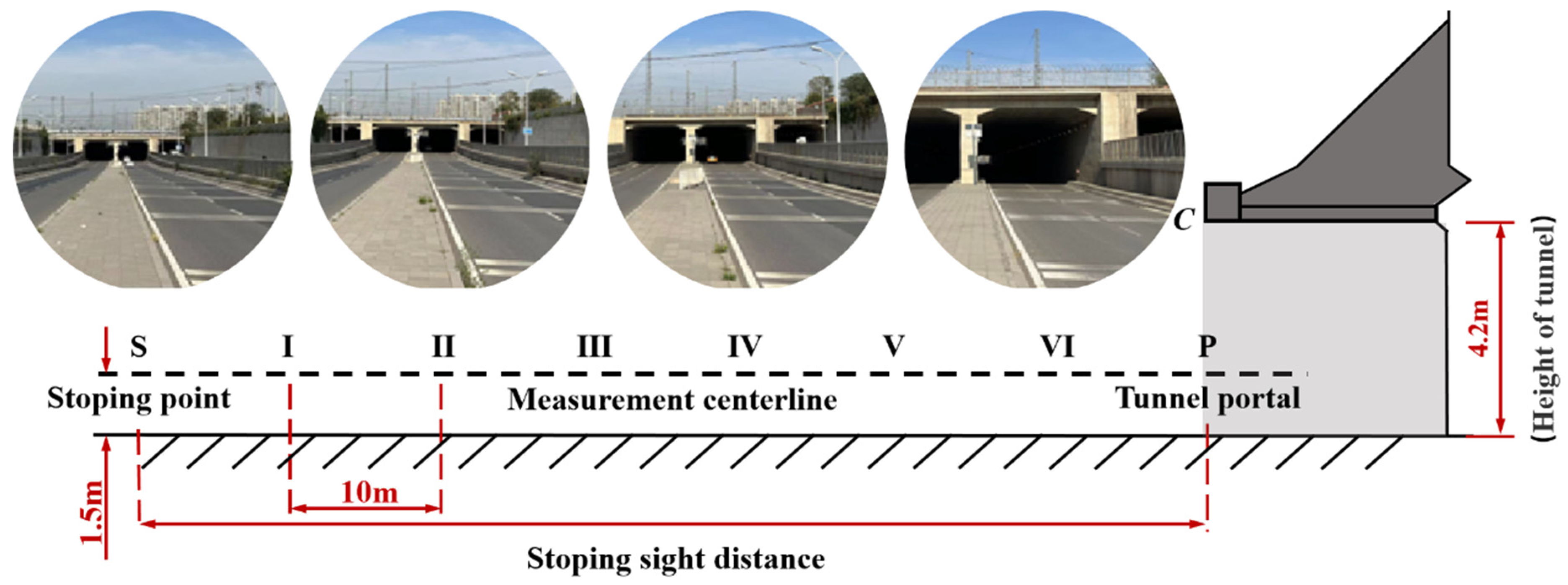
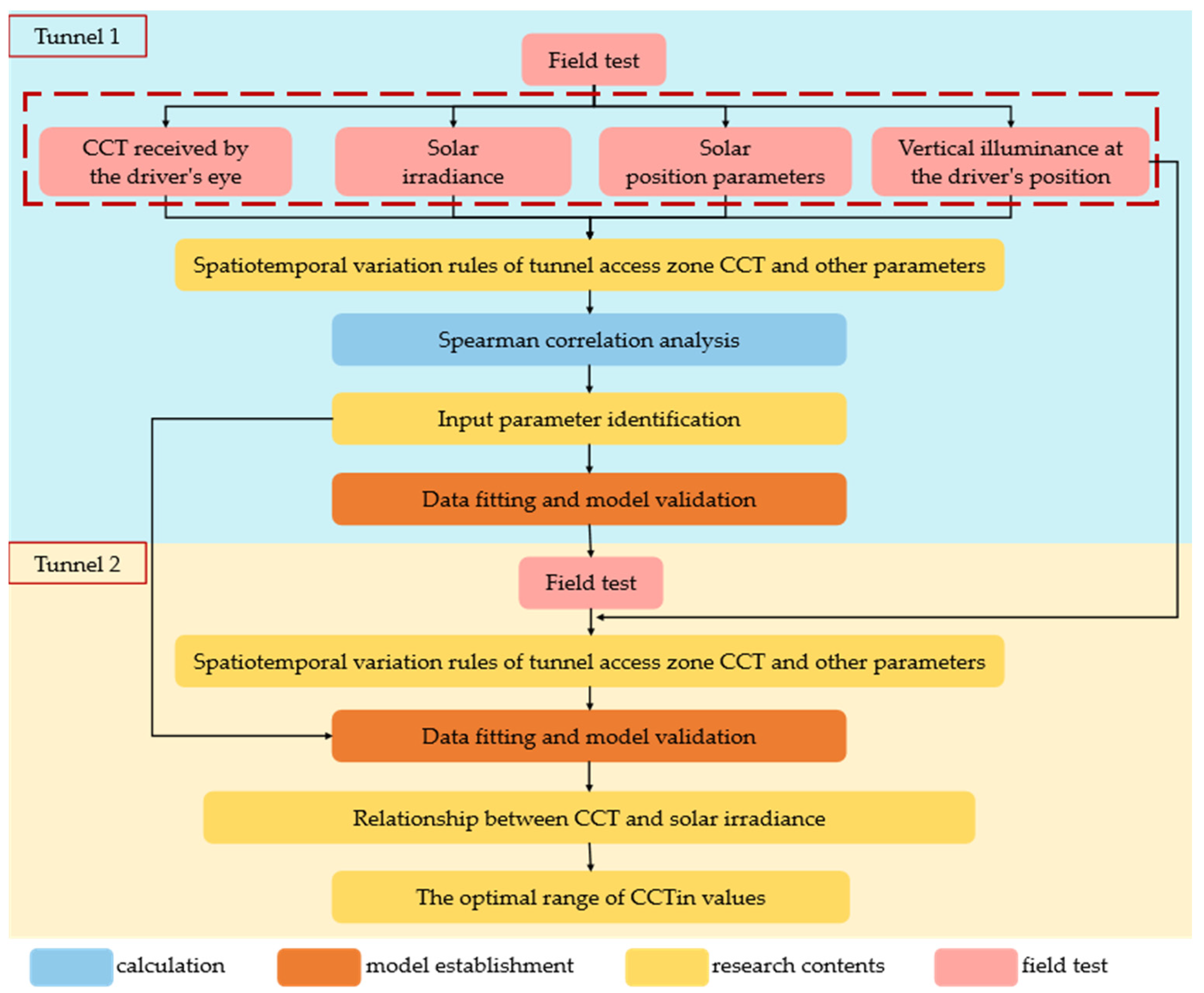
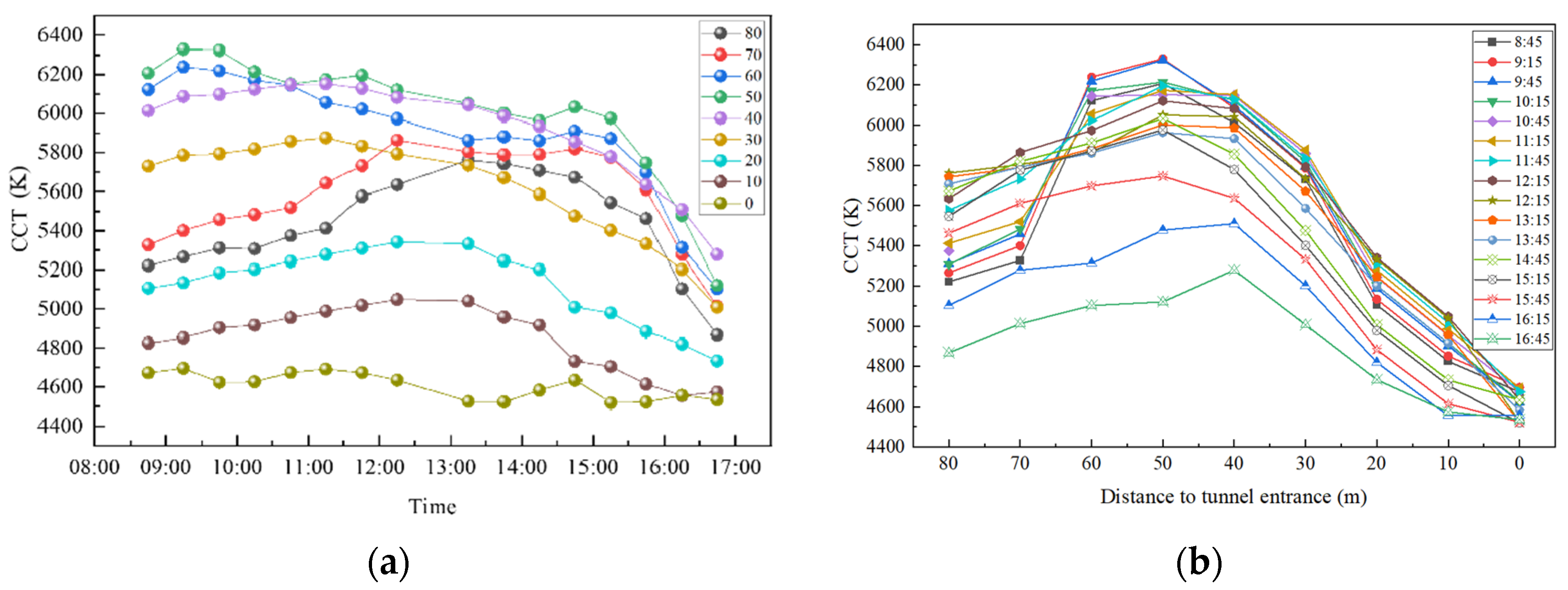
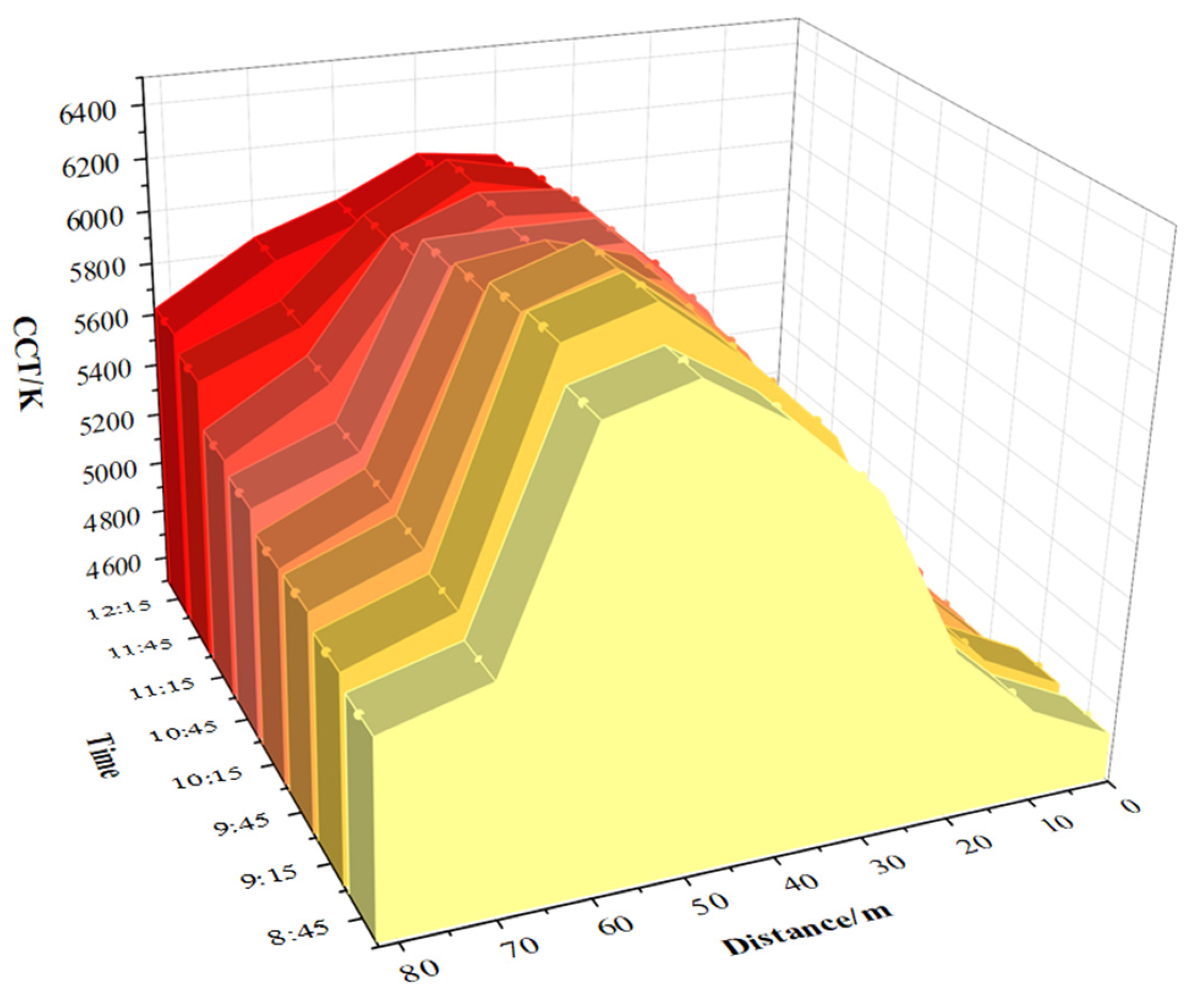
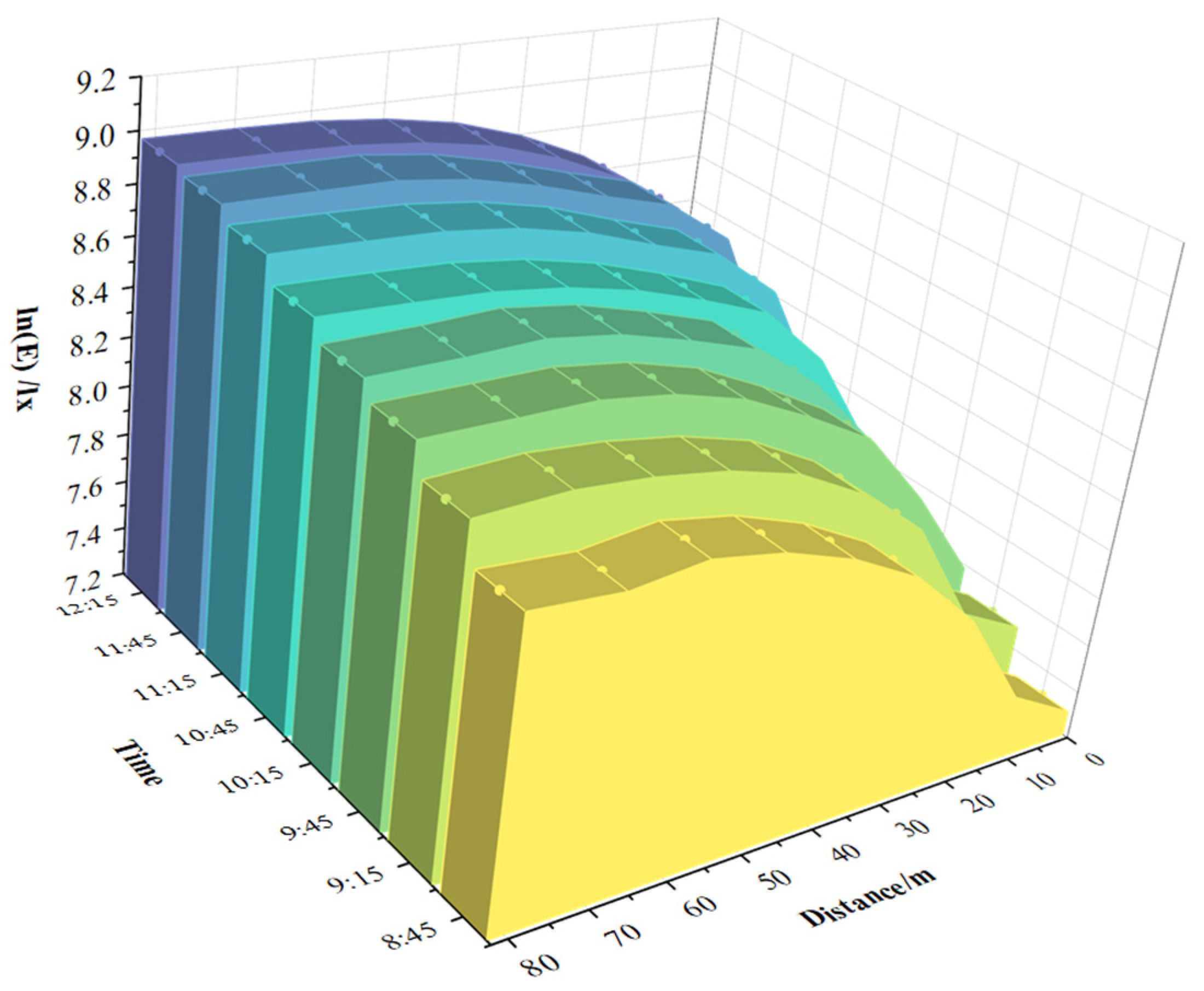

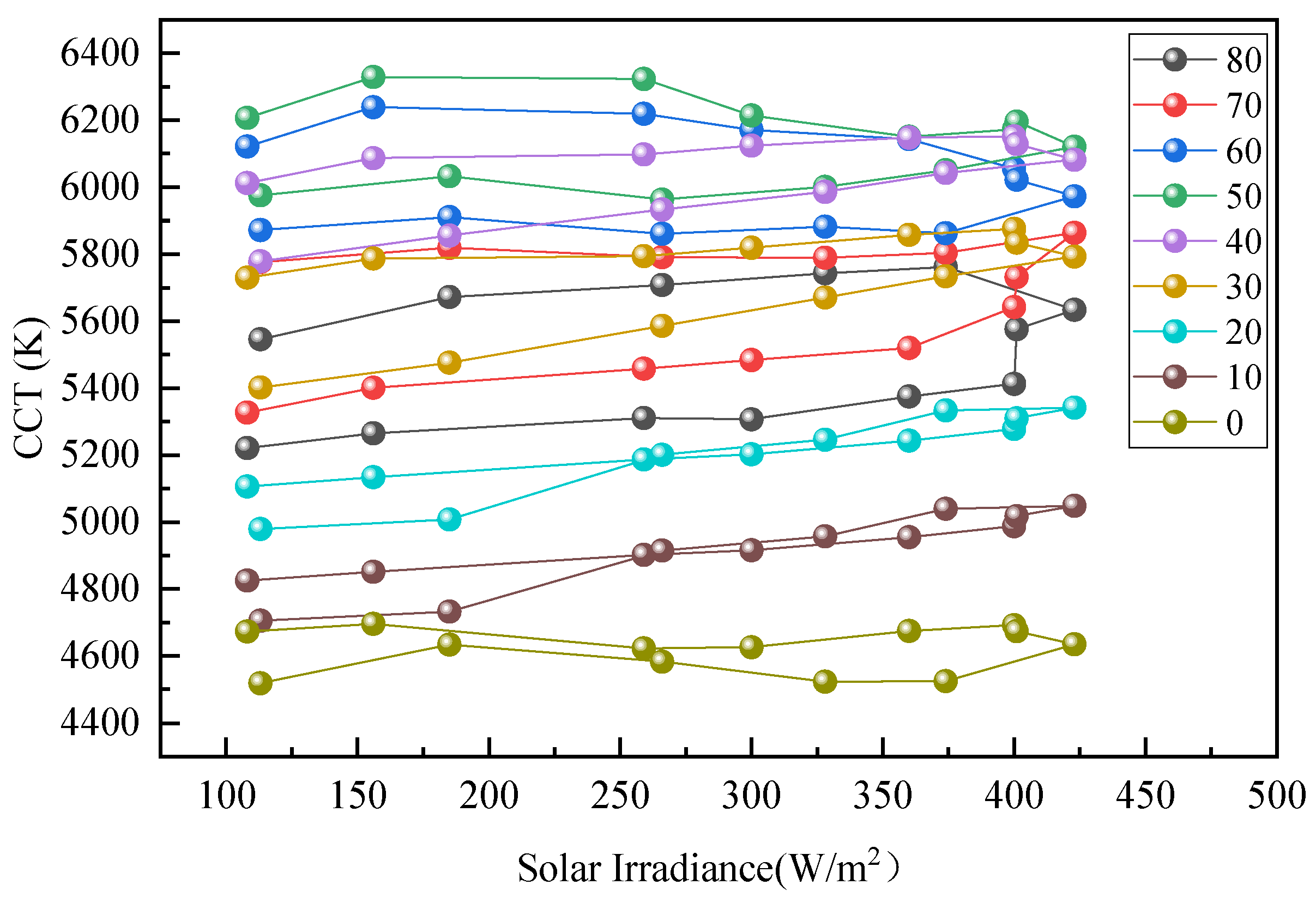
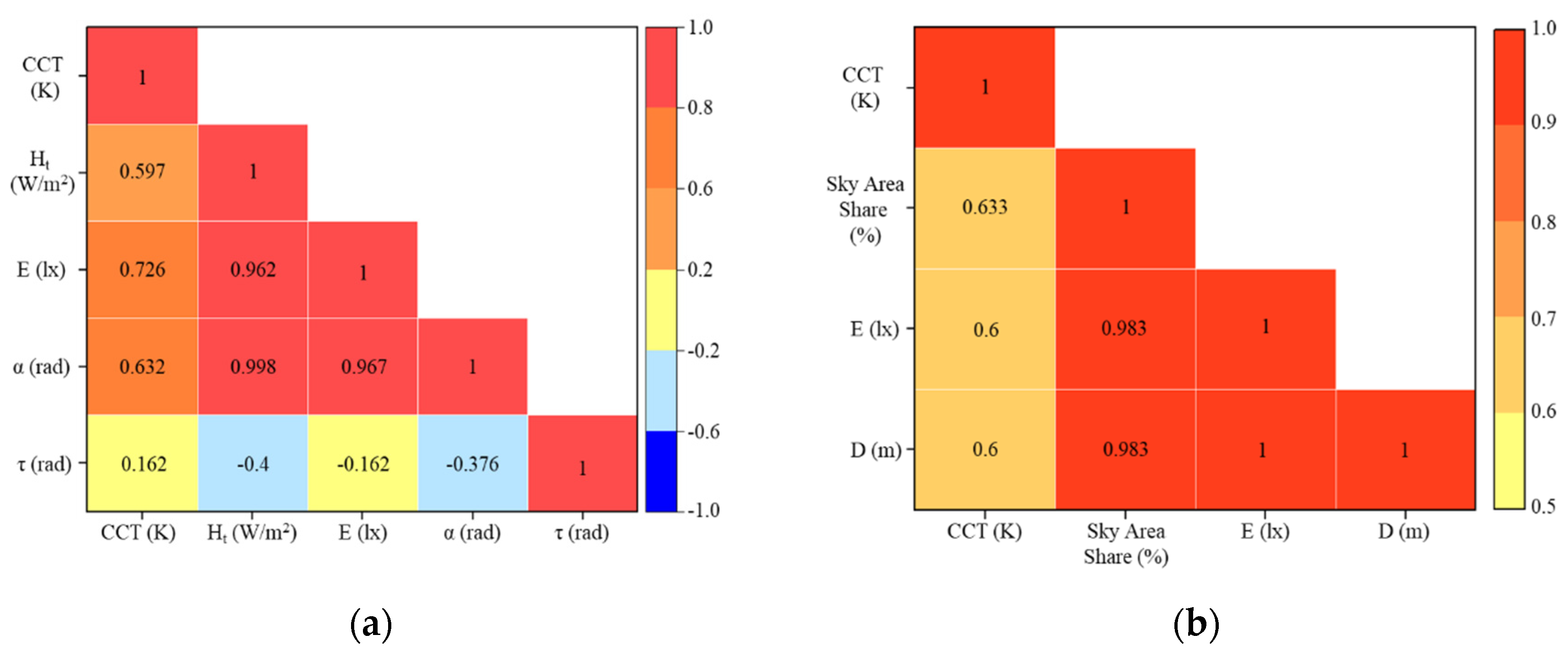

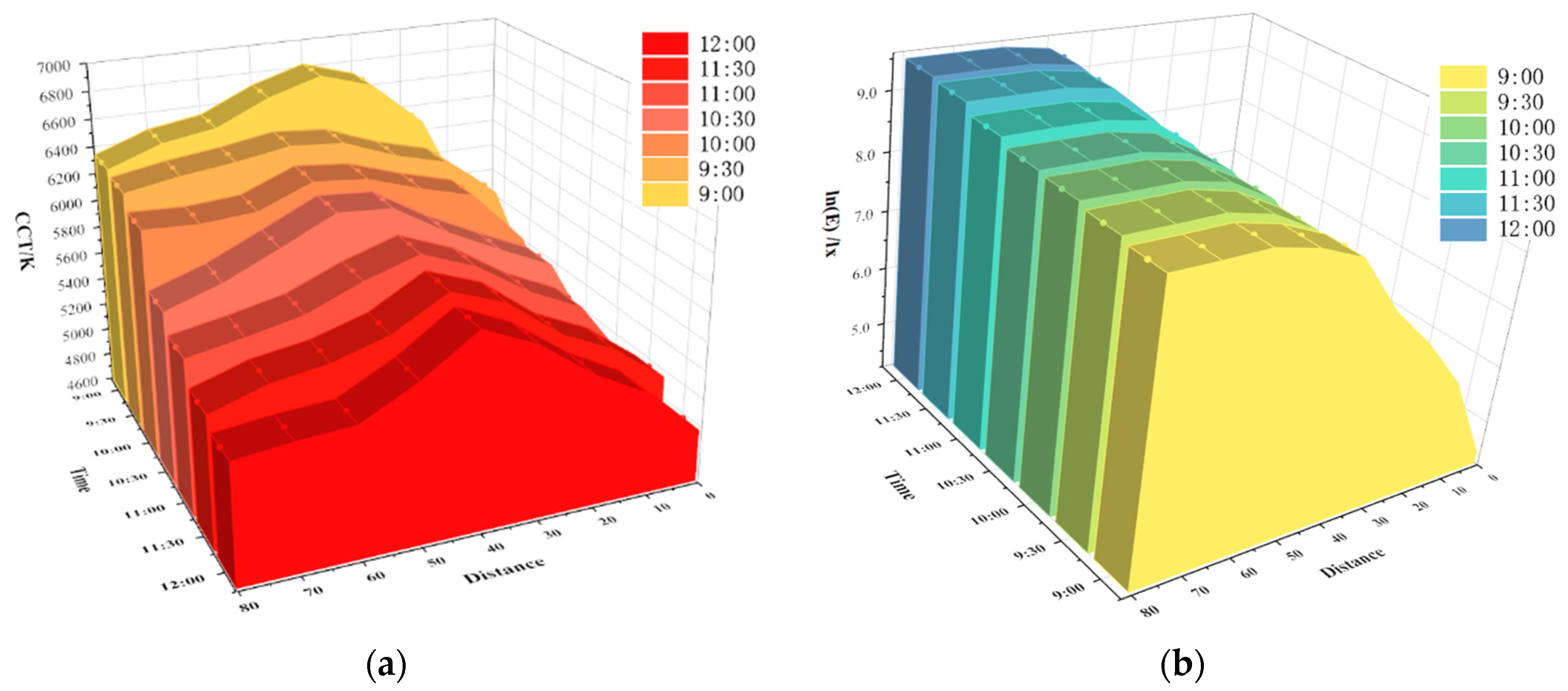
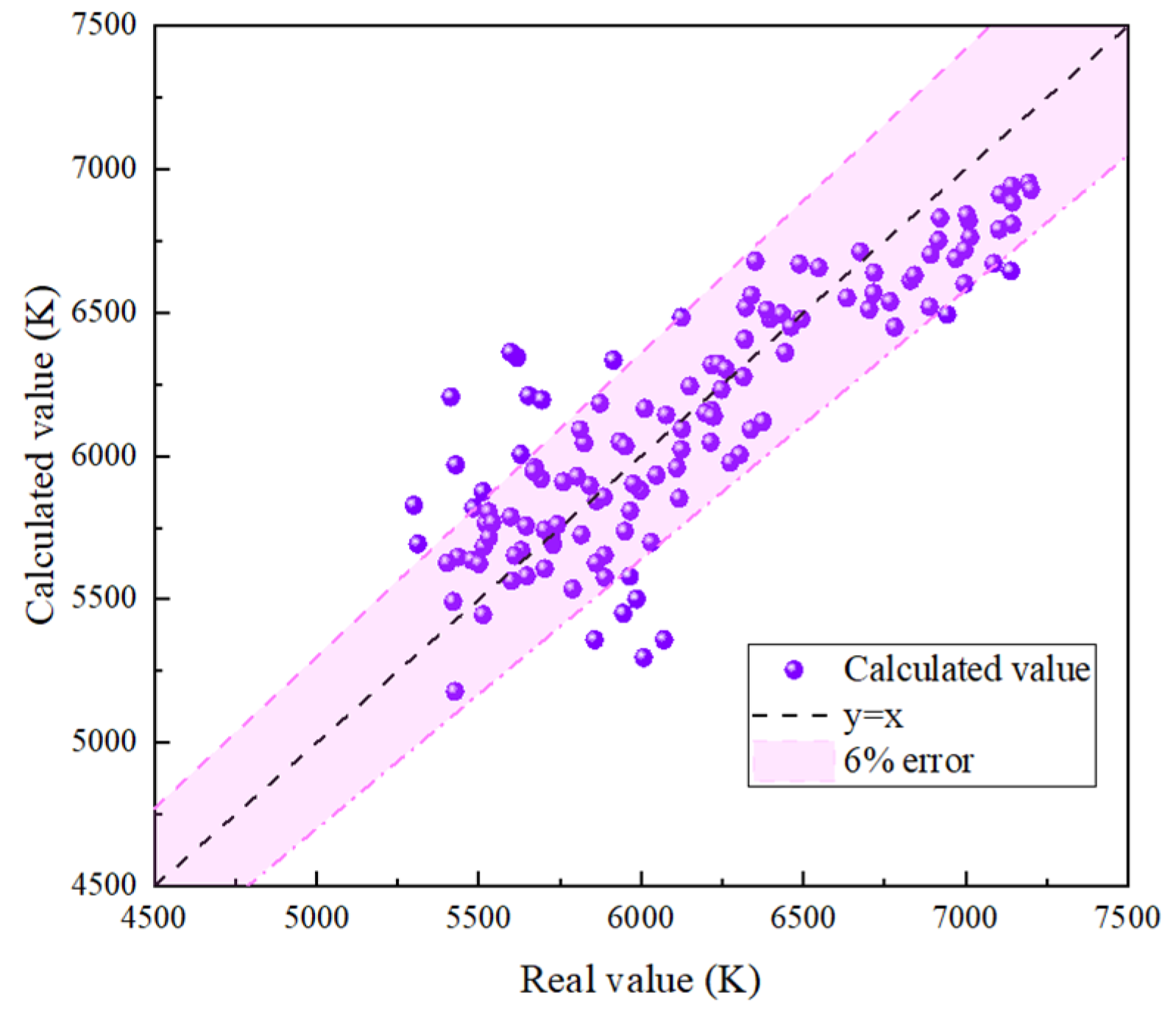

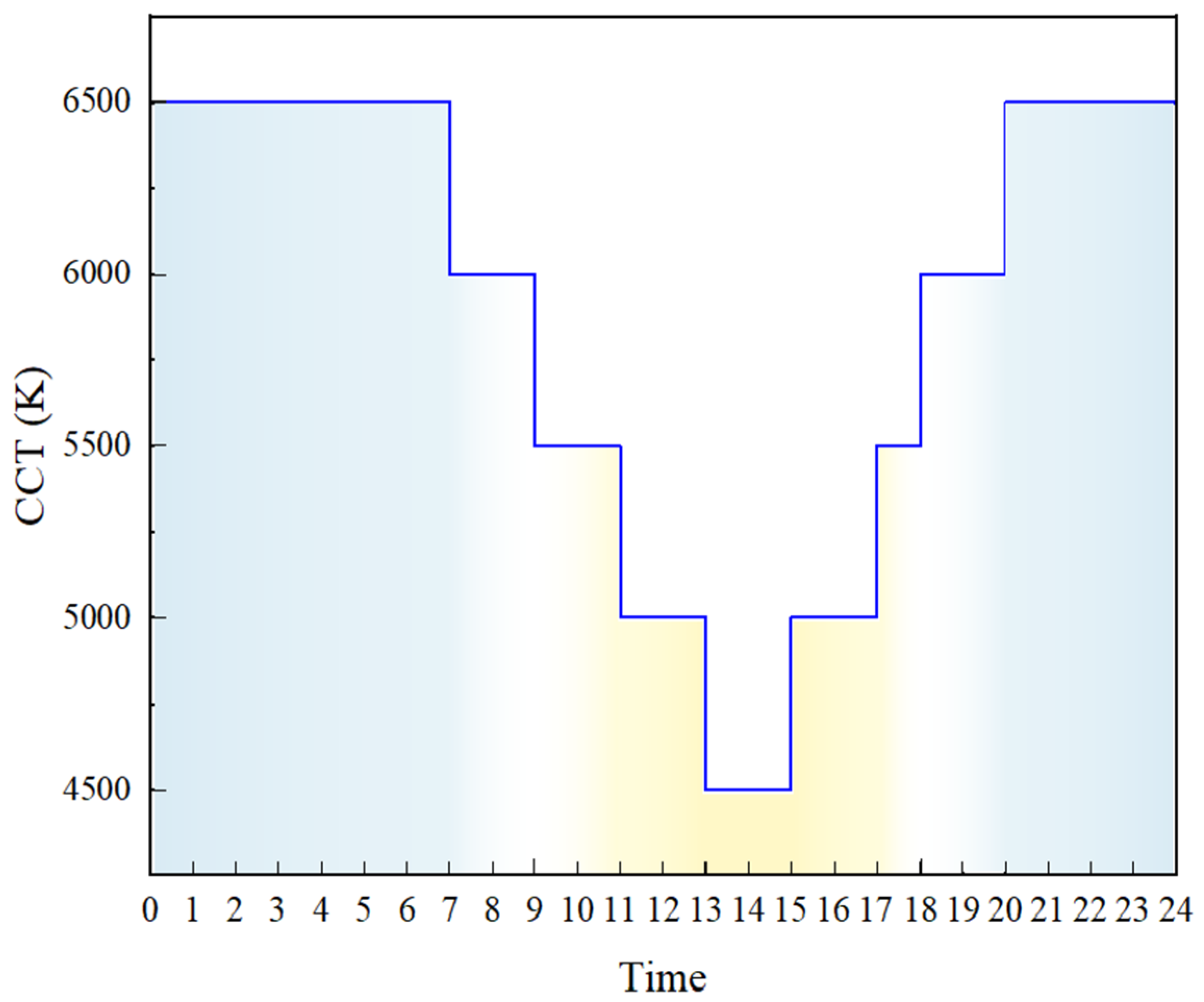
| Name | Location | Orientation | Slope |
|---|---|---|---|
| Luhua Road Tunnel | 116.3° E, 39.8° N | 15° North by West | 3% |
| Beiguan Tunnel | 116.6° E, 39.9° N | 28° South by East | 4% |
| Instrument | Picture | Test Content | Parameter | Value |
|---|---|---|---|---|
| Spectral Flickering Irradiance Meter |  | CCT | Range | 1518~100,000 K |
| Accuracy | ±3% | |||
| Vertical illuminance | Range | 1~220,000 l× | ||
| Accuracy | ±3% | |||
| Solar irradiance meter |  | Solar irradiance | Range | 0.01~2000 W/m2 |
| Accuracy | ±2% |
Disclaimer/Publisher’s Note: The statements, opinions and data contained in all publications are solely those of the individual author(s) and contributor(s) and not of MDPI and/or the editor(s). MDPI and/or the editor(s) disclaim responsibility for any injury to people or property resulting from any ideas, methods, instructions or products referred to in the content. |
© 2024 by the authors. Licensee MDPI, Basel, Switzerland. This article is an open access article distributed under the terms and conditions of the Creative Commons Attribution (CC BY) license (https://creativecommons.org/licenses/by/4.0/).
Share and Cite
Yu, Y.; Zhang, Y.; Wang, S.; Guo, Z.; Ni, Z.; Xue, P. Spatiotemporal Variation of Correlated Color Temperature in the Tunnel Access Zone. Sustainability 2024, 16, 4838. https://doi.org/10.3390/su16114838
Yu Y, Zhang Y, Wang S, Guo Z, Ni Z, Xue P. Spatiotemporal Variation of Correlated Color Temperature in the Tunnel Access Zone. Sustainability. 2024; 16(11):4838. https://doi.org/10.3390/su16114838
Chicago/Turabian StyleYu, Yangjian, Yuwei Zhang, Shaofeng Wang, Ziyi Guo, Zhikai Ni, and Peng Xue. 2024. "Spatiotemporal Variation of Correlated Color Temperature in the Tunnel Access Zone" Sustainability 16, no. 11: 4838. https://doi.org/10.3390/su16114838






